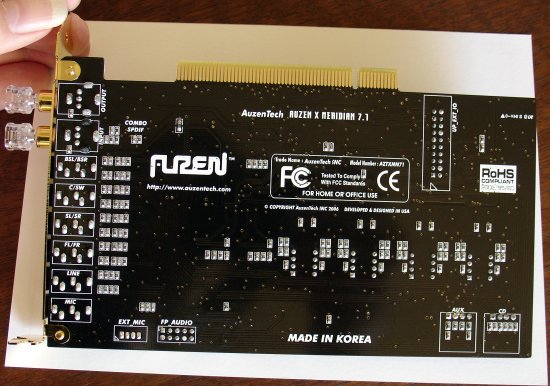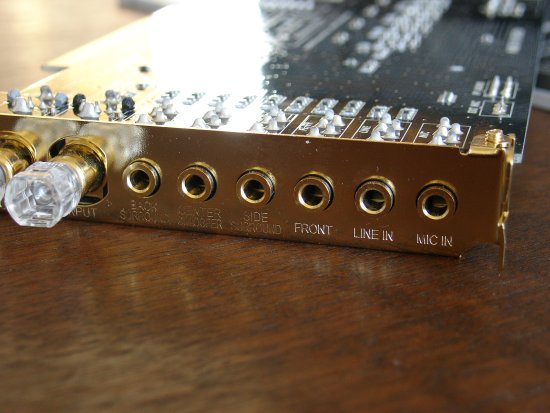Page 3 - Features Hardware
Hardware Details Continued
The heart of the beast is C-Medias CMI8788 DSP, the Oxygen HD, which is a high-performance audio processor chip.
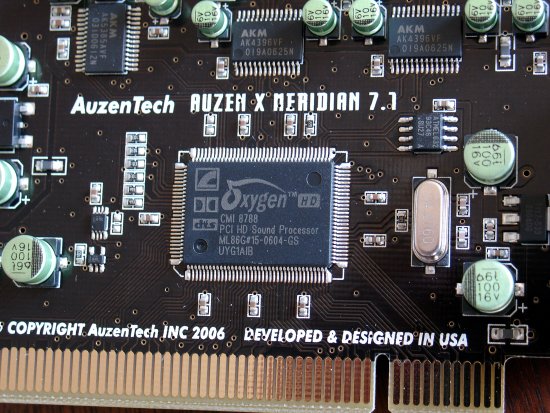
Exihibit A. Oxygen HD
This chip supports 12 channels of 32bit/192KHz outputs, and 8 channels of 32bit/192KHz inputs. 8 channels are devoted to analog (7.1 surround), and the other 4 channels are for the digital outputs. Thats what Id call a healthy processor. C-Media doesnt provide raw MIPS numbers for the CMI8788 like Creative does for the X-Fi, so its hard to guess what its raw performance is.
The digital-to-analog converters are very high in quality, AKM 4396VF, with 120dB dynamic range. These little buggers are extremely clean. The DAC is responsible for creating the analog sound we hear from a digital source, so their quality has a huge effect on the analog sound we hear. On the X-Meridian they are built into a simple circuit design, one for each pair of channels, where their quality can really shine through. A word of caution about sampling rates, though. It does not necessarily mean that a 192KHz sample rate is superior to a 96KHz one (more dots does not mean higher fidelity). As a general indicator of quality, sampling rate is pretty good, but I am of a mind that it is better to have more bits than higher sampling frequency.
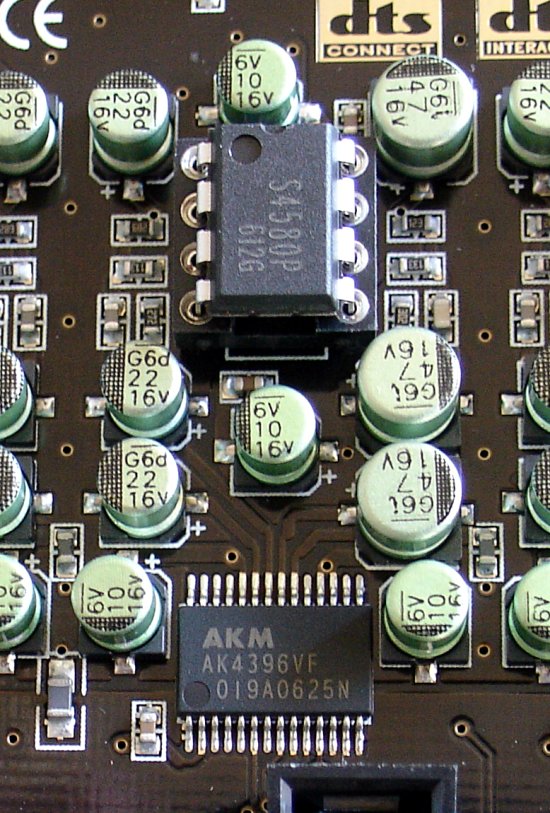
This is the front output circuit, which is simply repeated for the other channels.
This is a pretty simple circuit, DAC->Opamp->Speakers. This is a bit more complex than the fabled CMoy pocket amps, but not by much, and it certainly accounts for the X-Meridian's sound quality. There are 8-channel DAC's out there, which would be the most cost-efficient way to design a sound card, but by using individual 2-channel DAC's, Auzentech ensures the X-Meridian provides unmatched output.
There are interchangeable operational amplifiers, as noted above. Opamps are the last piece of hardware that touches the sound stream as it leaves the sound card. But, these also have an effect on the sound. The opamps on the X-Meridian are AUK Semi S4580P, a dual op-amp that are great for low voltage applications like a PC audio card. These puppies are most likely the reason the card is so bloody loud, too.
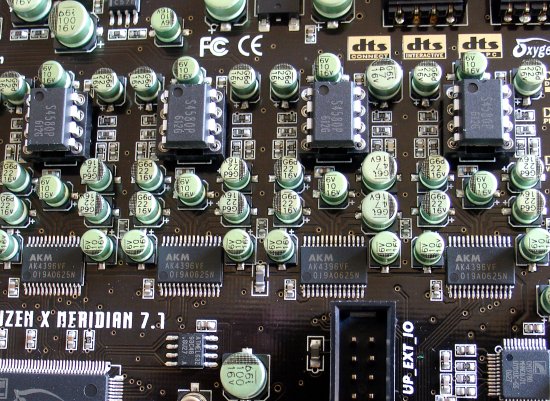
Each DAC only provides two channels, a costly way to do 8 channnels, but it ensures high quality output.
The same S4580P opamps are used for the inputs also, but they are soldered directly to the board and will definitely void the warranty if you decide to change them. I really didnt have any reason to change them though, as they are rather good.
The analog-to-digital converters, AKM 5385AVF, used for recording in the X-Meridian, are also only 2-channel ADC's but at a maximum resolution of 24bit/192KHz. This very high resolution on a line-in interface is attractive, although 96KHz would be enough for most jobs including converting your vinyl collection. You probably have figured it out already, but recording your voice in 24 bit/192KHz resolution is really great, if you had a microphone capable of such frequency response, but it is total, complete, and utter overkill otherwise. Take a look at the nice design, though.
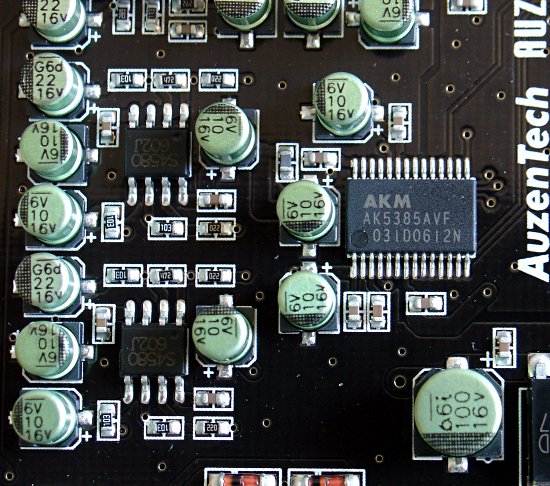
Two inputs for one ADC. Either the Mic-in is active or the Line-In.
We really like the simplicity of the circuits, with high-quality components all around, and the number of good-sized capacitors. This speaks volumes on Auzentech's commitment to high quality.
The backplane of the card, adorned in gold, sports the 8-channel analog outputs, a line-in, a mic-in, and two coax connectors for digital input and output. Each coax connector is capped with an odd-looking plastic thing, because they also handle the optical inputs and outputs too. If you feel the X-Meridian is lacking, then there is also an optional extension board that comes with even more inputs and outputs. It would boggle the mind if you did, though.
The X-Meridian also has on-board connectors for the microphone, line-in, and stereo output for the front connectors on some newer cases. But wait, there's more. There is also a connector for the extra daughterboard that has additional optical inputs and outputs.
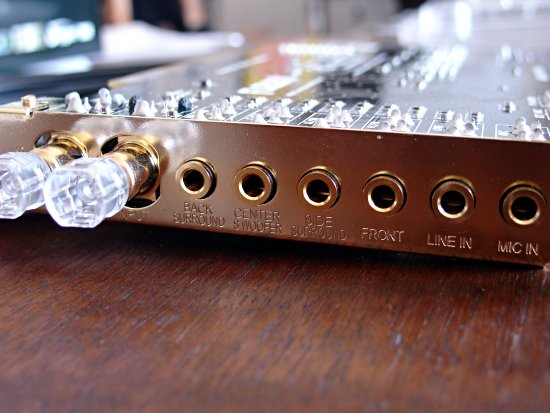
The backplane also happens to be mislabelled, with the side surround actually being the rear surrounds. Definitely watch out for that. Wait, yes, definitely.
Edit: It would appear that the backplane is not mislabeled, per se. ROBSCIX pointed out to me that if I had actually read the manual (I didn't), that this is correct for 7.1 speakers. For 5.1 systems, use the 'Side Surround' for the surrounds.
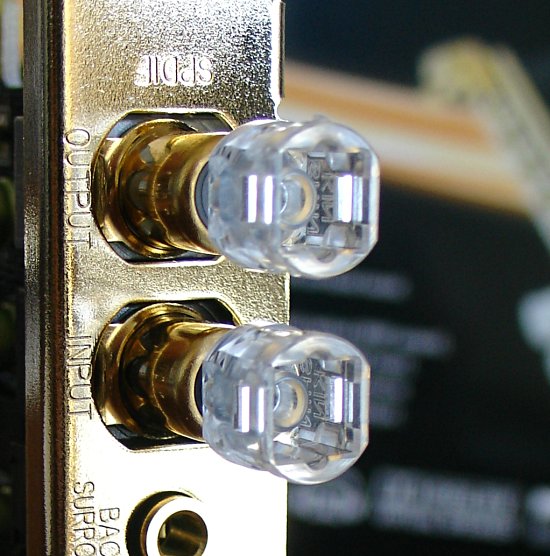
When active, the output glows an orange that reminds us of good old vacuum tubes.
The back of the X-Meridian reveals an Auzentech signature of sorts, with labels for all the various inputs and outputs. Its great for figuring out what is what if you have a window on your case. The RoHS logo simply means that Auzentech manufactures the X-Meridian without a lot of hazardous chemicals, like lead.
